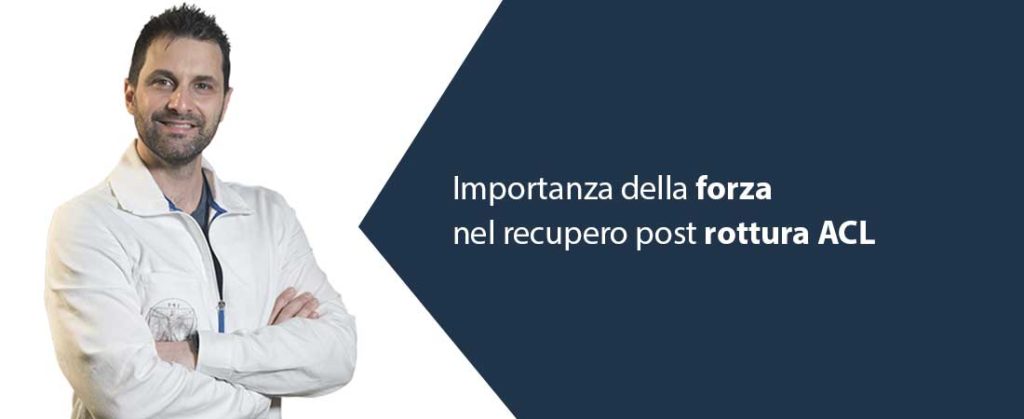L’importanza della forza dopo rottura del legamento crociato anteriore

Legamento crociato anteriore
L’infortunio del legamento crociato anteriore (ACL) è uno dei più comuni infortuni del ginocchio che spesso succede durante attività sportive (1)
È stato descritto che la forza del quadricipite è associata con la sua funzionalità e con la soddisfazione del paziente dopo la ricostruzione dell’ACL. (2,3,4).
Inoltre la forza del quadricipite è stata usata come uno dei criteri per determinare quando un paziente può ritornare all’attività sportiva. Ad esempio alcuni studi hanno suggerito che per tornare all’attività debba essere raggiunto almeno 85% (test isocinetico) della forza del quadricipite rispetto alla forza della gamba non coinvolta (5,6,7).
Sebbene non ci sia consenso riguardo i tempi precisi di ritorno allo sport dopo la ricostruzione dell’ACL, i pazienti tornano solitamente a giocare tra i 6 e i 12 mesi dopo l’operazione (8,9,10).
La ricostruzione con tendine rotuleo dell’ACL può influenzare la forza del quadricipite a causa di deficit di forza prima dell’intervento e per la larghezza minore post-operatoria del tendine rotuleo (11,12).
Per quanto concerne la ricostruzione con tendini degli hamstring (semitendinoso e gracile), dopo l’operazione è stata osservata una perdita di forza del quadricipite, i fattori causanti non sono stati esaustivamente esaminati anche in relazione ai tempi di ritorno allo sport. (13,14).
I fattori causanti sono stati studiati da Ueda et al. L’equipe ha riportato che l’indice di forza del quadricipite prima dell’operazione era associato in maniera indipendente con l’indice di forza post-operatorio facendo la ricostruzione con tendine degli hamstring, inoltre l’età e il genere femminile potrebbero essere fattori predittivi per una ritardata ripresa dopo intervento di ricostruzione dell’ACL, per quanto concerne il dolore post-operatorio al ginocchio esso è associato ad una bassa forza del quadricipite.
Il valore di cut-off dell’indice di forza preoperatorio del quadricipite in questo studio era 70,2%.
Pertanto, se l’indice preoperatorio di forza del quadricipite non è superiore al 70%, potrebbe essere consigliabile eseguire una riabilitazione pre-operatoria al fine di ottenere almeno l’85% dell’indice di forza del quadricipite 6 mesi dopo l’intervento chirurgico.
I chirurghi dovrebbero prendere in considerazione questi fattori per raggiungere e recuperare un livello sufficiente di forza del quadricipite rispetto al tempo di ritorno alle attività sportive dopo la ricostruzione del LCA utilizzando un tendine degli hamstring autologo (15).
Approfondimento
- Legamento crociato anteriore: rapporto con ischiocrurali e lavoro eccentrico
- Ricostruzione del legamento crociato anteriore: possibili tecniche e giusti tempi di recupero
- Infortuni sportivi: rottura del legamento crociato anteriore e rapporto con gli hamstring
Bibliografia
- Majewski M, Susanne H, Klaus S (2006) Epidemiology of athletic knee injuries: a 10-year study. Knee 13(3):184–188.
- Petschnig R, Baron R, Albrecht M (1998) The relationship between isokinetic quadriceps strength test and hop tests for distance and one-legged vertical jump test following anterior cruciate ligament reconstruction. J Orthop Sports Phys Ther 28(1):23–31.
- Xergia SA, Pappas E, Georgoulis AD (2015) Association of the single-limb hop test with isokinetic, kinematic, and kinetic asymmetries in patients after anterior cruciate ligament reconstruction. Sports Health 7(3):217–223.
- Zwolski C, Schmitt LC, Quatman-Yates C, Thomas S, Hewett TE, Paterno MV (2015) The influence of quadriceps strength asymmetry on patient-reported function at time of return to sport after anterior cruciate ligament reconstruction. Am J Sports Med 43(9):2242–2249.
- Myer GD, Paterno MV, Ford KR, Quatman CE, Hewett TE (2006) Rehabilitation after anterior cruciate ligament reconstruction: criteria-based progression through the return-to-sport phase. J Orthop Sports Phys Ther 36(6):385–402.
- Schmitt LC, Paterno MV, Ford KR, Myer GD, Hewett TE (2015) Strength asymmetry and landing mechanics at return to sport after anterior cruciate ligament reconstruction. Med Sci Sports Exerc 47(7):1426–1434.
- Van Grinsven S, van Cingel RE, Holla CJ, van Loon CJ (2010) Evidence-based rehabilitation following anterior cruciate ligament reconstruction. Knee Surg Sports Traumatol Arthrosc 18(8):1128–1144.
- Ardern CL, Webster KE, Taylor NF, Feller JA (2011) Return to the preinjury level of competitive sport after anterior cruciate ligament reconstruction surgery: two-thirds of patients have not returned by 12 months after surgery. Am J Sports Med 39(3):538–543.
- Delay BS, Smolinski RJ, Wind WM, Bowman DS (2001) Current practices and opinions in ACL reconstruction and rehabilitation: results of a survey of the American Orthopaedic Society for Sports Medicine. Am J Knee Surg 14(2):85–91.
- Shah VM, Andrews JR, Fleisig GS, McMichael CS, Lemak LJ (2010) Return to play after anterior cruciate ligament reconstruction in National Football League athletes. Am J Sports Med 38(11):2233–2239.
- Eitzen I, Holm I, Risberg MA (2009) Preoperative quadriceps strength is a significant predictor of knee function two years after anterior cruciate ligament reconstruction. Br J Sports Med 43(5):371–376.
- Shelbourne KD, Johnson BC (2004) Effects of patellar tendon width and preoperative quadriceps strength on strength return after anterior cruciate ligament reconstruction with ipsilateral bone–patellar tendon–bone autograft. Am J Sports Med 32(6):1474–1478.
- Gobbi A, Domzalski M, Pascual J (2004) Comparison of anterior cruciate ligament reconstruction in male and female athletes using the patellar tendon and hamstring autografts. Knee Surg Sports Traumatol Arthrosc 12(6):534–539.
- Iriuchishima T, Shirakura K, Horaguchi T, Wada N, Sohmiya M, Tazawa M, Fu FH (2012) Age as a predictor of residual muscle weakness after anterior cruciate ligament reconstruction. Knee Surg Sports Traumatol Arthrosc 20(1):173–178.
- Ueda Y, Matsushita T, Araki D, Kida A, Takiguchi K, Shibata Y, Ono K, Ono R, Matsumoto T, Takayama K, Sakai Y, Kurosaka M, Kuroda R (2016) Factors affecting quadriceps strength recovery after anterior cruciate ligament reconstruction with hamstring autografts in athletes. Knee Surg Sports Traumatol Arthrosc.
